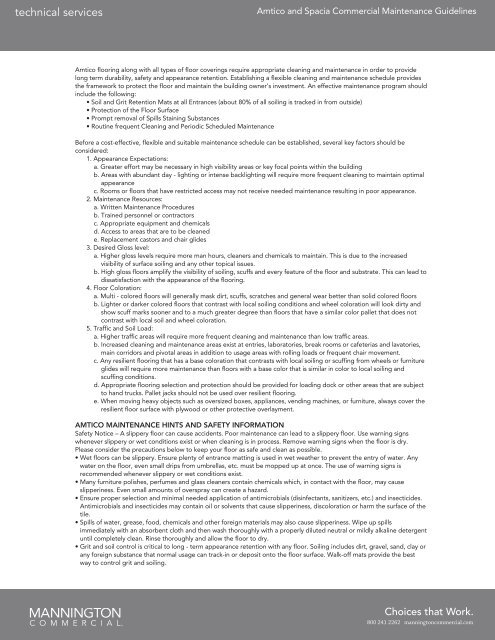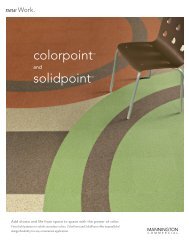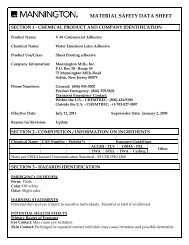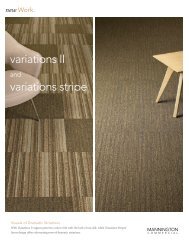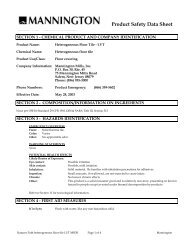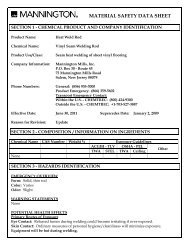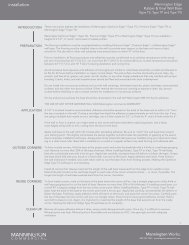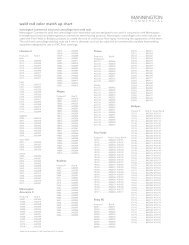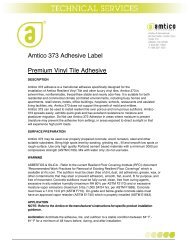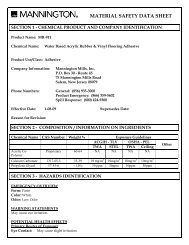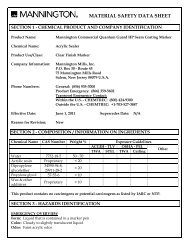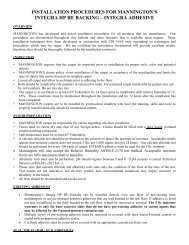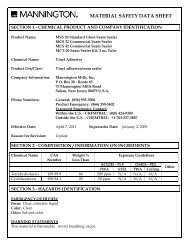Amtico/Spacia Maintenance Guidelines - Mannington
Amtico/Spacia Maintenance Guidelines - Mannington
Amtico/Spacia Maintenance Guidelines - Mannington
You also want an ePaper? Increase the reach of your titles
YUMPU automatically turns print PDFs into web optimized ePapers that Google loves.
technical services<br />
<strong>Amtico</strong> and <strong>Spacia</strong> Commercial <strong>Maintenance</strong> <strong>Guidelines</strong><br />
<strong>Amtico</strong> flooring along with all types of floor coverings require appropriate cleaning and maintenance in order to provide<br />
long term durability, safety and appearance retention. Establishing a flexible cleaning and maintenance schedule provides<br />
the framework to protect the floor and maintain the building owner’s investment. An effective maintenance program should<br />
include the following:<br />
• Soil and Grit Retention Mats at all Entrances (about 80% of all soiling is tracked in from outside)<br />
• Protection of the Floor Surface<br />
• Prompt removal of Spills Staining Substances<br />
• Routine frequent Cleaning and Periodic Scheduled <strong>Maintenance</strong><br />
Before a cost-effective, flexible and suitable maintenance schedule can be established, several key factors should be<br />
considered:<br />
1. Appearance Expectations:<br />
a. Greater effort may be necessary in high visibility areas or key focal points within the building<br />
b. Areas with abundant day - lighting or intense backlighting will require more frequent cleaning to maintain optimal<br />
appearance<br />
c. Rooms or floors that have restricted access may not receive needed maintenance resulting in poor appearance.<br />
2. <strong>Maintenance</strong> Resources:<br />
a. Written <strong>Maintenance</strong> Procedures<br />
b. Trained personnel or contractors<br />
c. Appropriate equipment and chemicals<br />
d. Access to areas that are to be cleaned<br />
e. Replacement castors and chair glides<br />
3. Desired Gloss level:<br />
a. Higher gloss levels require more man hours, cleaners and chemicals to maintain. This is due to the increased<br />
visibility of surface soiling and any other topical issues.<br />
b. High gloss floors amplify the visibility of soiling, scuffs and every feature of the floor and substrate. This can lead to<br />
dissatisfaction with the appearance of the flooring.<br />
4. Floor Coloration:<br />
a. Multi - colored floors will generally mask dirt, scuffs, scratches and general wear better than solid colored floors<br />
b. Lighter or darker colored floors that contrast with local soiling conditions and wheel coloration will look dirty and<br />
show scuff marks sooner and to a much greater degree than floors that have a similar color pallet that does not<br />
contrast with local soil and wheel coloration.<br />
5. Traffic and Soil Load:<br />
a. Higher traffic areas will require more frequent cleaning and maintenance than low traffic areas.<br />
b. Increased cleaning and maintenance areas exist at entries, laboratories, break rooms or cafeterias and lavatories,<br />
main corridors and pivotal areas in addition to usage areas with rolling loads or frequent chair movement.<br />
c. Any resilient flooring that has a base coloration that contrasts with local soiling or scuffing from wheels or furniture<br />
glides will require more maintenance than floors with a base color that is similar in color to local soiling and<br />
scuffing conditions.<br />
d. Appropriate flooring selection and protection should be provided for loading dock or other areas that are subject<br />
to hand trucks. Pallet jacks should not be used over resilient flooring.<br />
e. When moving heavy objects such as oversized boxes, appliances, vending machines, or furniture, always cover the<br />
resilient floor surface with plywood or other protective overlayment.<br />
AMTICO MAINTENANCE HINTS AND SAFETY INFORMATION<br />
Safety Notice – A slippery floor can cause accidents. Poor maintenance can lead to a slippery floor. Use warning signs<br />
whenever slippery or wet conditions exist or when cleaning is in process. Remove warning signs when the floor is dry.<br />
Please consider the precautions below to keep your floor as safe and clean as possible.<br />
• Wet floors can be slippery. Ensure plenty of entrance matting is used in wet weather to prevent the entry of water. Any<br />
water on the floor, even small drips from umbrellas, etc. must be mopped up at once. The use of warning signs is<br />
recommended whenever slippery or wet conditions exist.<br />
• Many furniture polishes, perfumes and glass cleaners contain chemicals which, in contact with the floor, may cause<br />
slipperiness. Even small amounts of overspray can create a hazard.<br />
• Ensure proper selection and minimal needed application of antimicrobials (disinfectants, sanitizers, etc.) and insecticides.<br />
Antimicrobials and insecticides may contain oil or solvents that cause slipperiness, discoloration or harm the surface of the<br />
tile.<br />
• Spills of water, grease, food, chemicals and other foreign materials may also cause slipperiness. Wipe up spills<br />
immediately with an absorbent cloth and then wash thoroughly with a properly diluted neutral or mildly alkaline detergent<br />
until completely clean. Rinse thoroughly and allow the floor to dry.<br />
• Grit and soil control is critical to long - term appearance retention with any floor. Soiling includes dirt, gravel, sand, clay or<br />
any foreign substance that normal usage can track-in or deposit onto the floor surface. Walk-off mats provide the best<br />
way to control grit and soiling.<br />
Choices that Work.<br />
800 241 2262 manningtoncommercial.com
technical services<br />
<strong>Amtico</strong> and <strong>Spacia</strong> Commercial <strong>Maintenance</strong> <strong>Guidelines</strong><br />
• Walk-off mats should have an abrasive open surface engineered to remove and retain soiling from the soles of shoes and<br />
retain liquid. Mats should be placed inside and outside of all entrances, should cover at least 4 to 6 steps into the building<br />
and be wider than the doorway. The base of mats should be anti-skid and non-staining (avoid rubber backed mats).<br />
• Make sure mats are used between kitchen areas and areas of smooth flooring to prevent tracking food.<br />
• Mats must be cleaned often by vacuuming to prevent redistributing trapped soiling or liquids. Walk-off mats when<br />
properly serviced can effectively remove the majority of abrasive and foreign materials from foot traffic and cut down on<br />
tracked in water. These will reduce the maintenance in entry areas and extend the life of the floor. Use extra mats in wet<br />
weather.<br />
• Protect the floor surface by using proper floor protection devices on furniture and equipment. The devices should be of<br />
sufficient size to carry the weight, have smooth, flat surfaces and rounded edges. For chairs and frequently moved<br />
furniture, use easy swiveling wide wheel casters or flat glides (minimum 1” diameter). Be sure castors have large diameter<br />
wheels. Do not use small or narrow casters or those with a crowned tread, as they can damage the floor. Replace when<br />
worn, damaged or sharp edges are present.<br />
• Staining can occur with any floor covering, especially with a light color. Common staining agents include asphalt,<br />
especially newly paved or with fresh sealer, some rubber based castors, furniture cups, shoe soles and polish and rubber<br />
backed mats. Some other potential staining items include liquid solvents, paste waxes, pigments, paints, petroleum by<br />
products and tires. Protect the floor from direct tire contact.<br />
• Choose and use maintenance products carefully. Products containing soap or unsuitable detergents like dishwashing<br />
liquid may leave hard to remove film on the surface. Abrasive cleaners can scratch or damage the floor surface. Using<br />
products at too high of a concentration may leave a residue and cause resoiling.<br />
• Mop treatments and sweeping compounds with solvents, silicone or abrasive particles are not recommended and may<br />
cause dull or shiny spots, make the floor slippery or scratch the surface.<br />
• Electrostatic Discharge (ESD): Although not a common issue, ESD can occur with any floor covering. The normal<br />
conditions resulting in static generation are low Relative Humidity (RH) and surface contamination. Other factors may<br />
include electrical leakage within a structure, individual sensitivity, footwear and clothing that generate static charge. An<br />
effective strategy to resolve ESD is to utilize a static dissipative floor cleaner like the following:<br />
Desco Industries - Statguard (508) 481-6849 www.statguardflooring.com<br />
JohnsonDiversey - Butchers (800) 225-9475 www.butchers.com<br />
AMTICO COMMERCIAL FINISH AND CLEANING CONSIDERATIONS<br />
<strong>Amtico</strong> flooring along with all types of floor coverings require a flexible and sustainable maintenance program in order to<br />
provide long term durability, safety and a lasting beautiful appearance. To help with specifying the right floor and<br />
understanding how to keep it looking its best, consider the following basic points.<br />
<strong>Amtico</strong> Floor Finish Options<br />
<strong>Amtico</strong> flooring can be purchased either with or without a factory applied urethane coating and can be maintained without<br />
a floor finish in many applications. When a floor finish is used, follow the recommended usage and application instructions<br />
of the floor finish manufacturer.<br />
There are several key considerations regarding the floor finish that will help guide the decision on whether or not to specify<br />
the <strong>Amtico</strong> flooring with a factory urethane coating and using a floor finish after installation.<br />
No Factory Urethane<br />
<strong>Amtico</strong> flooring without the factory urethane coating provides the following benefits:<br />
1. Desirable for end users that wish to provide a visually pleasing and healthy environment with minimal chemical usage<br />
(no strippers or harsh cleaners necessary for many applications).<br />
2. Over time, the floor develops an attractive patina surface that adds to the compelling character of <strong>Amtico</strong> Flooring.<br />
3. <strong>Amtico</strong> Flooring can be maintained on a comparable basis with other flooring products that offer low life cycle costs<br />
while providing superior visuals which adds to the value of using <strong>Amtico</strong> flooring.<br />
Factory Urethane Coating<br />
The urethane coating provides the following benefits:<br />
1. Immediate protection to the new flooring during construction or remodeling.<br />
2. The factory urethane coating provides ease of maintenance for many small to medium sized offices, retailers and<br />
boutiques that will be maintaining the flooring themselves.<br />
3. In many low to moderate traffic environments, the factory urethane coating can last for along time, further enhancing<br />
the ease of maintenance with <strong>Amtico</strong> flooring.<br />
Finish<br />
Applying a floor finish provides the following benefits:<br />
1. It increases protection of the floor in high usage areas like building entries, lobbies and main corridors or harsh usage<br />
areas like beauty salons, laboratories, etc.<br />
2. Provides the ability to have a medium or high gloss surface where that is desirable.<br />
Choices that Work.<br />
800 241 2262 manningtoncommercial.com
technical services<br />
<strong>Amtico</strong> and <strong>Spacia</strong> Commercial <strong>Maintenance</strong> <strong>Guidelines</strong><br />
3. Enables the use of a single maintenance system when installed with other resilient flooring.<br />
4. A floor finish can be added at any time offering increased flexibility.<br />
Be Prepared For Successful Cleaning<br />
1. Use a Matting system that is appropriate for soil load and weather conditions. Avoid rubber or latex backed mats<br />
as some types can cause permanent floor discoloration.<br />
2. Use non-marring Floor Glides on the base of all furniture and chair legs (minimum 1 inch wide with a flat surface).<br />
3. Have all cleaning supplies on hand and store and maintain equipment according to the manufacturer’s instructions.<br />
4. Ensure that maintenance personnel have proper training and support. This includes:<br />
a. How to properly dilute and use all chemicals and know where all supplies and MSD are kept.<br />
b. Knowledge in all aspects of equipment operation (when and how to change pads, fill and empty solution tanks,<br />
adjust pressure settings, clean equipment, etc).<br />
5. Maintain and store all cleaning supplies and equipment in accordance with the manufacturer’s instructions.<br />
6. Maintain rolling equipment to ensure that wheels are fully operational (roll, swivel, lock and unlock properly) and are<br />
clean.<br />
7. Use denatured alcohol to remove substances that do not clean off using a neutral cleaner.<br />
8. Use a non-abrasive scrubbing pad for difficult to remove substances and scuff marks.<br />
9. Do not drag or slide objects across the surface of the floor.<br />
10. Do not allow cigarettes, matches or other very hot items to come in contact with the floor.<br />
11. Do not use brown or black stripping pads for cleaning <strong>Amtico</strong>.<br />
12. Do not use abrasive cleaners as they can damage the floor or use detergent cleaners that leave a residue on the<br />
floor.<br />
13. Visit www.manningtoncommercial.com or contact Technical Services at 1-800-241-2262 for additional information.<br />
New Floor Initial <strong>Maintenance</strong><br />
Be sure to keep all traffic off of the newly installed floor for 1 day and avoid point loads and rolling traffic for at least 2 days.<br />
Wait 5 days to allow the adhesive to fully cure before routine or periodic scheduled maintenance, wet cleaning the floor, or<br />
applying a floor finish.<br />
SAFETY FIRST: Closely follow your company maintenance procedures and safety rules while performing maintenance<br />
operations. Before commencing work, put out signs or safety cones that cleaning is in progress.<br />
Day 1<br />
• Stay off the new floor.<br />
Day 2 to 4<br />
• Dust mop, sweep or vacuum the floor to remove loose dirt and grit.<br />
• Lightly damp mop (well wrung out mop) floor with Neutral Cleaner. Use minimal water with no machine cleaning.<br />
• Remove caution signs when the floor surface is dry and ready for use.<br />
Day 5<br />
• Begin Routine <strong>Maintenance</strong> including wet cleaning as outlined in the <strong>Amtico</strong> <strong>Maintenance</strong> Instructions.<br />
7/13<br />
Choices that Work.<br />
800 241 2262 manningtoncommercial.com


